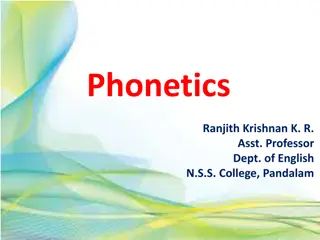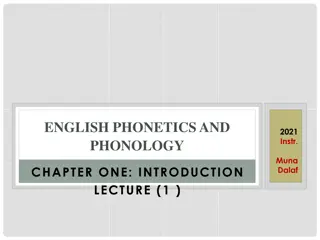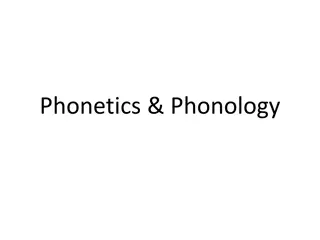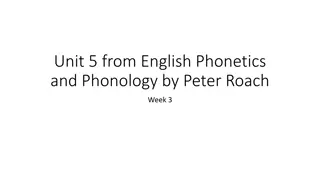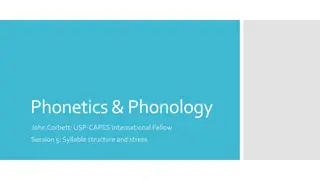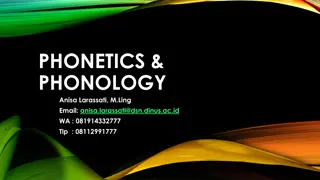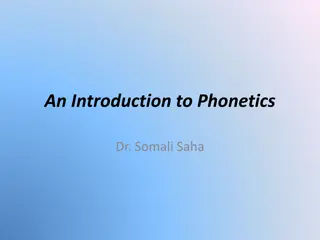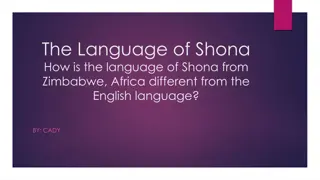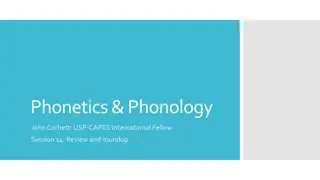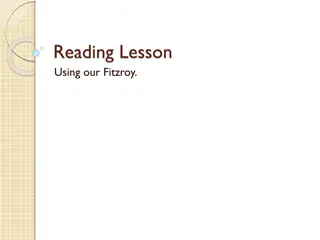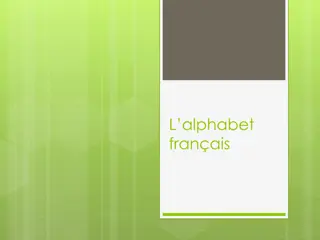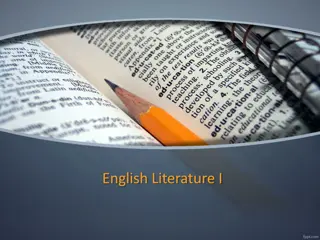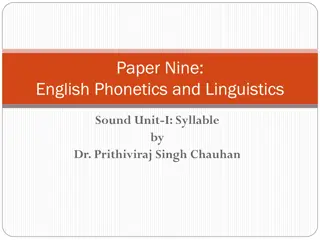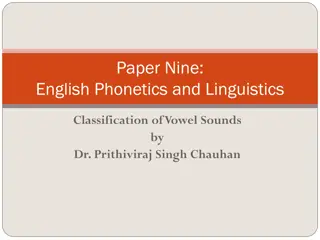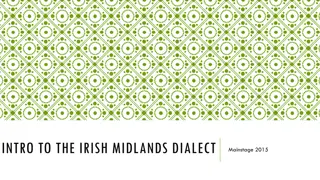Understanding Old English: Background, Alphabet, and Phonetics
Delve into the world of Old English with a focus on its general background, unique alphabet, and phonetic system. Explore the evolution of written records, the transition from runes to Latin letters, and the phonetic principles that governed Old English writings. Uncover the rich history and linguistic intricacies of this ancient language.
Download Presentation

Please find below an Image/Link to download the presentation.
The content on the website is provided AS IS for your information and personal use only. It may not be sold, licensed, or shared on other websites without obtaining consent from the author. Download presentation by click this link. If you encounter any issues during the download, it is possible that the publisher has removed the file from their server.
E N D
Presentation Transcript
OLD ENGLISH Lecture 2
2.1. Old English: General Background 2.2. The Old English Alphabet 2.3. The Old English Phonetic System 2.4. The Old English Grammar 2.5. The Old English Vocabulary and Literature
OLD ENGLISH: GENERAL BACKGROUND No written records of OE in the period of 5th- 6thc. The beginning of writing in OE is referred to the end of the 7th the beginning of the 8thcentury. The four dialects of OE: Kentish, Mercian, Northumbrian, and West Saxon. The majority of the surviving documents from the OE period were written in the West Saxon dialect spoken in Wessex, (Alfred the Great). Much of the OE literature was written in or translated into the West Saxon dialect. Thus, the source of most of the OE texts studied today is West Saxon.
THE OLD ENGLISH ALPHABET OE was first written with a version of the Runic alphabet known as Anglo-Saxon runes. This alphabet contained between 26 and 33 letters. Anglo-Saxon runes were used from the 5thto the 10thc. Runes started to be replaced by the Latin alphabet from the 7thcentury, and after the 9thcentury the runes were used mainly in manuscripts (the introduction of Christianity). After the Norman Conquest (the 11thcentury), the runes were no longer in use.
THE OLD ENGLISH ALPHABET OE scribes used Latin letters to represent the sounds of their language wherever they seemed to fit. They include: a, b, c, d, e, f, =g, h, i, l, m, n, o, p, r, s, t, u, x, y. The letters k and z were only occasionally used; The letter q was not used; ModE j and v were variants of OE i and u; ME letter w developed from OE uu; Some written symbols to indicate OE sounds that cannot be found in present-day English: ash ( sc), thorn, eth (capital was written ).
THE OLD ENGLISH ALPHABET OE writings were based on a phonetic principle: each letter indicated a separate sound; not always observed. Some letters could indicate three or more sounds. The same letters stood for both short and long sounds: long vowels were often indicated by a macron (a line over the top).
THE OLD ENGLISH ALPHABET In reading, the following rules should be observed: The letter =g stands for [g] before any consonant or back vowels, after n e.g. g g d (good), gr n (green); for [j] when preceding or following any front vowel, e.g. giefan (to give), d g (day); for [ ] while standing after back vowels or after r, l, e.g. dagas (days), folgian (to follow). f, s, ( ) are voiced when between vowels and voiced consonants, e.g. risan (to rise), hlafas (halves), w fes (wives)
THE OLD ENGLISH PHONETIC SYSTEM The Word Stress The word stress in OE was fixed no matter what grammatical form a word had. OE stress fell on the first syllable of a simple word. Words with a prefix had their stress either on the prefix or on the root syllable. The prefix ge- was unaccented; prepositional prefixes, e.g. for-, ofer-, could be either accented (in nouns or adjectives) or unaccented (in verbs). Compound words where both words retained their full meaning had a secondary stress on the 1stsyllable of the 2ndelement.
THE OLD ENGLISH PHONETIC SYSTEM The OE sound system underwent global changes, particularly these changes occurred within the vowels. Vowel Changes Breaking short vowels becoming diphthongs before certain consonant clusters (r, l, h + a consonant or h final), e.g. Goth. kalds > OE ceald (cold) Shortening of unstressed long vowels. As a result of this, all the long vowels became short, and all the diphthongs were monophthongized in an unstressed position: e.g. Goth. nam > OE nama (name)
THE OLD ENGLISH PHONETIC SYSTEM Consonant Changes Voicing of fricatives, if a fricative was surrounded by vowels or voiced consonants, it became voiced, e.g. OE w f (wife) > OE w fes (wives) [f] > [v] Palatalization made the pronunciation closer to present-day English. Velar consonants were palatalized before / after a front vowel (e, i) and remained velar before back vowels a, o, u., e.g. OE cild [k ] > [t ] Loss of consonants: n was often lost before h, f, s, , as a result, the preceding vowel became lengthened. h was often lost between vowels etc. e.g. *finf > OE fif (five)
THE OLD ENGLISH GRAMMAR: NOUN The OE noun had TWO numbers: singular, plural THREE genders masculine (M), feminine (F), and neuter (N). M and N nouns in general shared their endings, whilst F nouns had their own set of endings. The plural did not distinguish between genders. DECLENSION, i.e. different endings were attached to the stem of a word, and indicated what case a word belonged to and, thus, what grammatical function the word performed in a sentence. There were FOUR cases: the nominative, the accusative, the genitive, and the dative. The nominative case the subject of the sentence, the accusative the direct object. The genitive case possession. The dative the indirect object of the sentence.
THE OLD ENGLISH GRAMMAR: ADJECTIVE The OE adjective had the same categories as nouns: four cases (nominative, genitive, dative, and accusative), three genders (masculine, feminine, and neuter), and two numbers (singular and plural). Adjectives had strong or weak forms. The weak forms were used in the presence of a determiner, while the strong ones were used in other situations. Most of the endings of the strong adjective declension were identical to those of the strong declension of nouns, while most of the endings of the weak adjective declension were the same as those of the weak nouns.
THE OLD ENGLISH GRAMMAR The Degrees of Comparison The comparative and the superlative were normally formed from the positive with the help of the suffixes -ra and ost, e.g., w s (wise) w sra w sost Several adjectives had suppletive forms of the comparative and superlative: g d (good) betera betst
THE OLD ENGLISH GRAMMAR: PRONOUN There existed the following types of: personal, demonstrative, interrogative, and indefinite. The grammatical categories of the pronouns were either similar to those of nouns, or corresponded to those of adjectives. Personal Pronouns had the categories of number, gender, and case. The 1stand 2ndperson had three forms of number: singular, plural and dual (in Early OE) but no gender distinctions. The 3rdperson singular had three genders: masculine, feminine and neuter. The 2ndperson had distinct singular and plural forms ( - g ).
THE OLD ENGLISH GRAMMAR: PRONOUN The possessive pronouns were derived from the genitive case of the personal pronouns. Demonstrative Pronouns could also act as a noun determiner (the definite article) indicating its gender, number, and case: es (this) and s (that). Interrogative Pronouns hw (who) and hw t (what) had a four-case paradigm. Indefinite pronouns were numerous, e.g., sum (some), nig (any), gehwil (everything, anything), n ning (nothing) etc.
THE OLD ENGLISH GRAMMAR: VERB The OE verb had two tenses (present and past) and three moods (indicative, subjunctive, and imperative). The verb agreed with the subject in number and person, however, the distinction was not always obvious because there were homonymous forms in some of the persons. The forms of the Present Tense were used to indicate present and future actions, while the Past tense was used to indicate all past actions and events. All the forms of the verb were synthetic, while the analytic forms started to appear.
THE OLD ENGLISH GRAMMAR: VERB OE verbs fell into two main groups: strong and weak verbs. Strong Verbs formed their stems by means of ablaut and by adding special suffixes. There were about 300 strong verbs in OE, all of them were of Proto-Germanic origin and had parallels in other Old-Germanic languages. The strong verbs were divided into 7 classes. All of them had the same endings but differed in the root vowels which distinguished the four stems (Infinitive, Past Singular, Past Plural, and Participle II). Class 1: b tan (to bite) b t biton biten
THE OLD ENGLISH GRAMMAR: VERB The Present and Past Indicative were formed by means of endings. Weak Verbs were more numerous than strong verbs. All the new verbs which appeared in the OE period were weak. The distinctive feature of the weak verbs was that they formed their Past tense and Participle II by means of the dental suffix containing -d- or -t- . c pan (to keep) c pte c pt, c ped
THE OLD ENGLISH GRAMMAR: VERB The OE Imperative Mood (2nd person, singular and plural) was formed from the Infinitive: For example, the imperative forms of the strong verb singan (to sing) (Class 3): Sing! (2ndperson Sg); Singa ! (2ndperson Pl). The forms of the OE Subjunctive Mood were synthetic. The Present Subjunctive expressed unlikeness, the Past Subjunctive unreality and impossibility.
THE OE VOCABULARY AND LITERATURE The OE vocabulary is believed to have 24,000 lexical items in the Old English corpus. The OE language is mainly Germanic, while loan words are an insignificant part of it. Native words of the OE language are subdivided into the following etymological layers: - common Indo-European words, for example: f der (father), sittan (sit), re d (red), etc., - common Germanic words, for example: gr ne (green), h fod (head), t ma (time), sumor (summer), - a few specifically English words, which are not found in any other language, for example, clipian (call), wimman (wife), brid (bird) etc.
THE OE VOCABULARY AND LITERATURE Word-Formation The main word-building patterns were affixation and composition. Productive word-building prefixes: -, be-, for-, fore-, ge-, ofer-, un-. Productive word-building suffixes -end, -ere, - , -u , -o , -ung / -ing, -ig, -lic. prefixes forming verbs (less productive with other parts of speech); suffixes forming nouns and adjectives. Composition an abundance of compound words, especially, nouns, e.g. fent d (evening time), m nand g (Monday), h ligd g (holiday), sunnand g (Sunday) etc.
THE OE VOCABULARY AND LITERATURE Borrowing in Old English Borrowings constituted only a small part of the OE vocabulary (~ 6 hundred words). Two sources of borrowing in OE were Latin and Celtic, though, by the end of the OE period, new words appeared from the language of the Danes. Borrowing from Celtic can be mainly found in place names: Kent, York, possibly, London, Thames, Avon, Dover, Usk, Esk etc.
THE OE VOCABULARY AND LITERATURE Some words came into the language through Germanic contacts with the Romans before the invasion and settlement of Britain (the 1st the 5thcentury AD). They refer to home, agriculture, and building, e.g. mil (Lat. millia passum), w n (Lat. vinum), etc. Some Latin loan-words adopted in Britain are represented by the place names used by the Celts, e.g., castra in the shape caster, ceaster found in Dorchester, Winchester, Manchester, Lancaster, and wic (Lat. vicus village ), in Norwich, Woolwich etc. Christianising of Britain (late 6thcentury AD) and until the end of Old English. Two major thematic groups: religious and educational terms, e.g., biscop (bishop), clerec (clerk), mynster (minster), munuc (monk), sc l (school), sc lere (scholar).
THE OE VOCABULARY AND LITERATURE The last source of borrowing is Scandinavian, which is directly related to political events that occurred at the end of Old English. The words of Scandinavian origin are place names, e.g., Eastoft, Langtoft, Whitby, Derby, etc., words associated with sea voyages, e.g., b tswegen (boatman), barda (beaked ship), dreng (warrior), a number of words relating to law or to administrative system, and some everyday terms which make part of the present-day English word-stock.
THE OE VOCABULARY AND LITERATURE Old English Literature The most important works of the Old English literature: Beowulf, an epic poem describing adventures of legendary heroes; the Anglo-Saxon Chronicle, a record of early English history; Caedmon s Hymn, a religious poem. There are also a number of surviving prose works, biblical translations, legal documents, and works on grammar, medicine, and geography.
Thank you for your attention!!!


